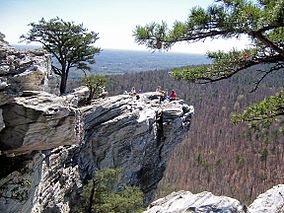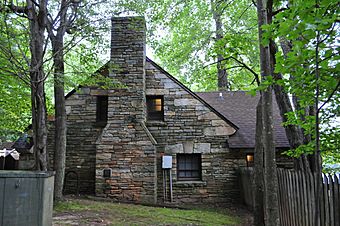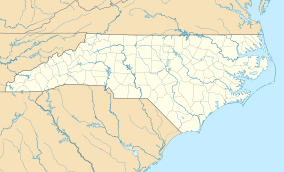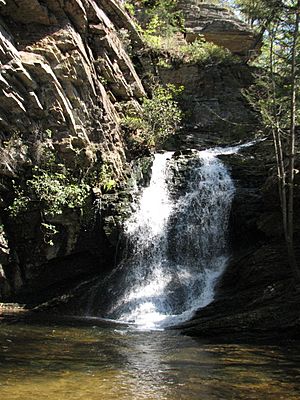Hanging Rock State Park facts for kids
Quick facts for kids Hanging Rock State Park |
|
|---|---|
|
IUCN Category III (Natural Monument)
|
|

Enjoying the view from Hanging Rock State Park
|
|
| Location | Stokes, North Carolina, United States |
| Area | 9,011 acres (36.47 km2) |
| Established | 1935 |
| Governing body | North Carolina Division of Parks and Recreation |
| Website | Hanging Rock State Park |
|
Hanging Rock State Park Bathhouse
|
|

Hanging Rock State Park Bathhouse, September 2013
|
|
| Lua error in Module:Location_map at line 420: attempt to index field 'wikibase' (a nil value). | |
| Nearest city | Danbury, North Carolina |
| Area | 24 acres (9.7 ha) |
| Built | 1939 |
| Built by | Civilian Conservation Corps |
| Architect | Robert S. Ormand |
| Architectural style | Rustic |
| NRHP reference No. | 91001507 |
| Added to NRHP | October 24, 1991 |
Hanging Rock State Park is a large North Carolina state park in Stokes County, North Carolina. It covers about 9,011 acres (about 36 square kilometers). The park is located about 30 miles (48 km) north of Winston-Salem. It is also very close, about 2 miles (3.2 km), to the town of Danbury.
Contents
A Park is Born: History of Hanging Rock
The land for Hanging Rock State Park was given to North Carolina on April 20, 1936. Two groups, the Winston-Salem Foundation and the Stokes County Committee for Hanging Rock, helped make this happen. Before this, people wanted to build a mountain resort on the highest peak, but their plans fell through.
Building the Park: Civilian Conservation Corps
After the state got the land, the Civilian Conservation Corps (CCC) built the first buildings and areas. The CCC was a program during the Great Depression that gave jobs to young men. They worked from 1935 to 1942. They built a 12-acre (4.9 ha) lake and a bathhouse. The bathhouse was later added to the National Register of Historic Places in 1991.
Growing the Park: New Additions
More land was added to the park in the 1970s. This included the Lower Cascades, a beautiful 40-foot (12 m) waterfall. Also added was Tory's Den, a rock cave. People say it was a hiding spot for British Loyalists during the American Revolutionary War. In 2000, Flat Shoals Mountain was added. This is a smaller mountain you can see from the top of Hanging Rock.
Where is Hanging Rock State Park?
Hanging Rock State Park is in the Sauratown Mountain Range. This is one of the most eastern mountain ranges in North Carolina. People sometimes call them "the mountains away from the mountains." This is because the Sauratown range has isolated mountains called monadnocks. They are separate from the bigger Blue Ridge Mountains nearby.
Peaks of the Sauratown Mountains
The Sauratown Mountains are completely within Stokes and Surry counties. The highest points in this range are between 1,700 feet (518 m) and 2,500 feet (762 m) high. This is much taller than the surrounding flat land, which is only about 800 feet (244 m) high. The most famous peak in this area is Pilot Mountain, which is in Pilot Mountain State Park.
The highest point in Hanging Rock State Park is Moore's Knob. It is also the highest point in the entire Sauratown Mountain range. Moore's Knob reaches 2,579 feet (786 m) above sea level.
How the Mountains Were Formed
The Sauratown Mountains are named after the Saura Native Americans, who lived here long ago. The rocky tops of these mountains are what's left of a very old, thick layer of rock. Over many, many years, wind and water wore away the softer rock around them. What is left are strong, hard rocks called quartzite. These rocks now form the beautiful ridges and peaks you see today. Some of these include Moore's Knob, Moore's Wall, Cook's Wall, Devil's Chimney, Wolf Rock, and Hanging Rock itself.
Nature at the Park: Plants and Animals
Because of its special location, Hanging Rock State Park is home to many plants. Some of these plants are usually found only in the western part of North Carolina. For example, Carolina and Canadian hemlock trees grow together here. In the spring, you can see colorful rhododendron, mountain laurel, pinxter azalea, and many other wildflowers. Most of the park is an oak-hickory forest, with chestnut oak trees being very common.
Amazing Animals of Hanging Rock
The park is also home to the rare Wehrle's salamander. You might even see peregrine falcons nesting on the high cliffs. Ravens and vultures often fly in circles overhead. If you walk on the park trails, you might spot white-tailed deer and wild turkey.
There are two types of venomous snakes in the park: the copperhead and the timber rattlesnake. These snakes will not bother you unless they feel threatened. It is always best to leave all wildlife alone. All animals in Hanging Rock State Park are protected, just like in all other North Carolina State Parks.
Fun Things to Do at Hanging Rock
Hanging Rock State Park has over 18 miles (29 km) of trails. You can hike to many peaks and waterfalls. The park also has a campground with 73 sites for tents and trailers. There are also 10 vacation cabins if you want to stay overnight.
Lake Activities
The lake and bathhouse are open from June to Labor Day. You can go swimming in the lake or rent a boat.
Climbing and Exploring
Rock climbing is allowed at Moore's Wall and Cook's Wall. However, climbing is not allowed at the very top of Hanging Rock. The park has a visitor's center and a museum room that are open every day. There is no fee to enter the park.
Connecting Trails
The Mountains-to-Sea Trail goes through the park. It also connects with the Sauratown Trail.
Waterfalls to Explore
Hanging Rock State Park is home to at least five important waterfalls. They are listed here from tallest to shortest:
Nearby State Parks
These state parks are within 30 miles (48 km) of Hanging Rock State Park:



